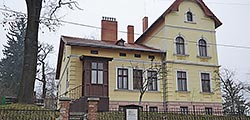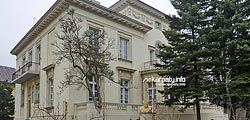Ukraine
Lviv region
Lviv and surroundings
Lviv
Museums, galleries, art exhibitions
Lviv National Museum
of Ivan Franko
Description:
The museum's opening ceremony took place 10 October, 1940. During the Nazi occupation it didn't work; and the exhibits were moved to the National Museum, city library and the office of T. Shevchenko Scientific Society. Back then, the museum building was significantly harmed by a bomb. It was opened in its original place 27 July, 1945.
Nowadays, the total number of exhibits is about 30 thousand being placed in two buildings. First one is a villa, where famous Ukrainian writer, poet, translator, public and political figure Ivan Franko lived with his family during last 14 years of his life (1902-1916). The residence was designed by the author's wife Olha Fedorivna, as the prototype the house of V. Antonovych (Kyiv city) was taken and the construction works were led by Polish masters M. Zakhodny and Tseslevych.
Getting into the villa, visitors are emerged into the atmosphere of the poet's everyday life, with typical for those times and place household items and personal possessions of I. Franko and members of his family. The exposition starts in the entryway and continues through five rooms (library, writer's bedroom, dining room, working room (previously — salon), women's room).
Among the most precious exhibits, there are paintings of I. Trush (famous Ukrainian artist), who was the poet's close friend. There are also I. Franko's most favourite books, fishing equipment and decorations in Hutsul style, which the owner of the house used to appreciate a lot. Ivan Franko spent the most time in his library, which had a book collection considered one of the best private ones in Lviv of its time. According to the writer's will, after his death the library and his archive were moved to the office of T. Shevchenko Scientific Society in Lviv. They were stored there until 1950, and later transferred to the Institute of Literature named after T. Shevchenko (Kyiv, NAS of Ukraine), where they are kept till present time. Nowadays, in the villa visitors can see books, newspapers and journals of I. Franko's times, and some analogues of the books from the original collection. The second floor was opened for visitors in 2006, with two more expositions: Olha Franko's room and children's room (sons of the writer, Taras and Petro). In the second museum building, which was added to the complex later, literary exposition is displayed. It was opened at the 150th anniversary of I. Franko. It starts from the room 'Greatness of Ivan Franko', where the author's bust (sculptor D. Krvavych) is placed in the centre, and visitors can see around historical and biographical materials investigating the life and work of I. Franko. Among those is a 10-volume biography by the winners of National Award of T. Shevchenko — R. Horak and Y. Hnativ, which is an exceptionally profound research of Ivan Franko's life. There are also some translation works of the writer made in different languages. The separate section is entitled 'Forbidden Study of Franko', where visitors can see literary works of historians (S. Yefremov, M. Khvyliovy, M. Vorony), whose researches of Ivan Franko's life and work were banned by the Soviet government, which resulted in many of them having been executed and their works forgotten for a long time. The other sections of the literary exposition:- The University Hall, where exhibits represent the history of I. Franko education and his first literary works (first published books, poems) and private photographs.
- The Hall of Literature, whith historical photos, writer's letters to his wife and a wide collection of his books.
- The Hometown Hall, where writer's childhood years are represented. There are his first biographical stories with memories about his childhood and school years, photographs of his primary school, his family and friends, illustartions of his works and models of the family house in Nahuyevychi village (made in 1981), where I. Franko was born and raised.
Entrance fees:
Adults — 50 UAH.
Students — 30 UAH.
Children — 20 UAH.
Pensioners — 20 UAH
Family (2 adults, 1 children) — 100 UAH.
Guided tours:
up to 4 persons — 50 UAH,
5-20 persons — 10 UAH per person.
Thematic excursion, in foreign language — 30 UAH per person.
Visitors who are allowed for free:
Students — 30 UAH.
Children — 20 UAH.
Pensioners — 20 UAH
Family (2 adults, 1 children) — 100 UAH.
Guided tours:
up to 4 persons — 50 UAH,
5-20 persons — 10 UAH per person.
Thematic excursion, in foreign language — 30 UAH per person.
Visitors who are allowed for free:
- children of pre-school age (up to 6 years old);
- orphaned children;
- disabled children;
- military students;
- active service members;
- ATO participants and their family members;
- members of the conscript service;
- Chernobyl liquidators;
- Heroes of Ukraine;
- museum workers.
Working hours:
10:00-16:00, Tuesday — day off.
Contact info:
How to get there:
By public transport
Go by buses # 30, 53 or 54 from the city centre ('Lvivska Politechnika' bus stop), or go by trams # 2 or 8.
More information about public transport.
By car
Go from the city centre along Ivan Franko street untill you see the museum on the right.
Go by buses # 30, 53 or 54 from the city centre ('Lvivska Politechnika' bus stop), or go by trams # 2 or 8.
More information about public transport.
By car
Go from the city centre along Ivan Franko street untill you see the museum on the right.
GPS:

 Ukraine
Ukraine Poland
Poland Slovakia
Slovakia
 Українською
Українською


























































































































